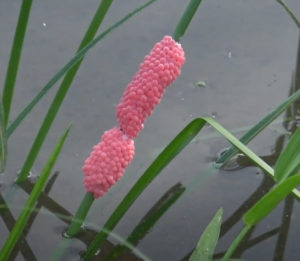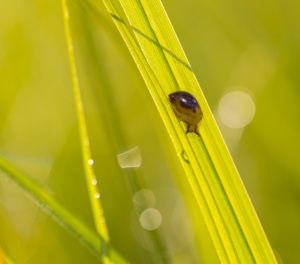Controlling Golden Apple Snail in Rice Fields: History, Challenges, and Solutions
The Golden Apple Snail (Pomacea canaliculata and related species) has emerged as a significant threat to rice production across the globe. This invasive pest wreaks havoc on rice crops, causing substantial yield losses and challenging farmers’ livelihoods. In this blog, we explore the history of the Golden Apple Snail, the problems it poses to rice crops, and effective, sustainable strategies to control its spread in rice fields.
 A Brief History of the Golden Apple Snail
A Brief History of the Golden Apple SnailThe Golden Apple Snail, native to South America, was first introduced to Asia in the 1980s as a potential food source and aquarium species. Countries like Taiwan and the Philippines imported the snail, hoping it would serve as a high-protein food for local communities. However, the snail’s unpalatability and rapid reproduction led to its release into natural waterways, where it quickly became an invasive species.
By the 1990s, the snail had spread across Southeast Asia, including Thailand, Vietnam, Indonesia, and Malaysia, as well as parts of Australia and the United States. Its adaptability to diverse environments, high reproductive rate (laying up to 2,000 eggs per clutch), and lack of natural predators in non-native regions fueled its proliferation. Today, the Golden Apple Snail is recognized as one of the world’s 100 most invasive species, with rice fields being its primary target.
The Problem: Golden Apple Snail’s Impact on Rice Crops
Golden Apple Snails pose a severe threat to rice production, particularly in wetland and irrigated rice systems. The snails feed voraciously on young rice seedlings, often destroying entire fields within days. Key issues include:
- Crop Destruction: Snails consume rice plants at the seedling stage, cutting stems and leaves, which prevents tillering and reduces yields. In severe infestations, farmers may face 50-100% crop loss.
- Economic Losses: Yield reductions translate to significant financial impacts for farmers, threatening food security and rural economies.
- Ecosystem Disruption: The snails outcompete native species, alter aquatic ecosystems, and contribute to nutrient imbalances in rice paddies.
- Resistance to Control: Traditional chemical molluscicides are often ineffective, expensive, and harmful to non-target organisms, including fish, birds, and beneficial insects.
The snail’s ability to thrive in flooded rice fields, coupled with its resilience to environmental stressors, makes it a formidable pest that requires integrated and sustainable control measures.
Effective Strategies to Control Golden Apple Snail in Rice Fields
Controlling Golden Apple Snail infestations requires a combination of cultural, biological, and eco-friendly approaches to minimize crop damage while preserving the environment. Below are proven strategies for managing this pest in rice fields:
1. Cultural Practices
Modifying farming practices can significantly reduce snail populations and their impact on rice crops:
- Water Management: Draining rice fields periodically during the early growth stages (first 10-15 days after transplanting) reduces snail mobility and feeding. Shallow water levels (2-3 cm) also limit snail reproduction.
- Transplanting Older Seedlings: Using rice seedlings older than 21 days reduces their susceptibility to snail damage, as older plants are less palatable and more resilient.
- Hand-Picking and Egg Removal: Manually collecting snails and destroying their bright pink egg masses (found on plant stems, rocks, or canal banks) is labor-intensive but effective, especially in small-scale farms.
- Crop Rotation and Dry Season Tillage: Rotating rice with dryland crops or tilling fields during the dry season exposes snails to desiccation and predation, reducing their population.

2. Biological Control
Leveraging natural predators and microbial solutions offers a sustainable approach to snail control:
- Encouraging Natural Predators: Ducks, fish (e.g., common carp), and birds (e.g., herons) feed on Golden Apple Snails. Introducing ducks into rice fields after the seedling stage can significantly reduce snail numbers while providing additional farm income.
- Microbial Solutions: Products like MicrobeBio® X8™ use beneficial microorganisms (Bacillus subtilis, Trichoderma harzianum, Azotobacter) to suppress snail populations. These microbes produce compounds that disrupt snail reproduction and create an environment favorable to natural predators, all while improving soil health and reducing reliance on chemical pesticides.
3. Physical and Mechanical Controls
Physical barriers and traps can prevent snails from accessing rice fields:
- Bamboo Stakes or Nets: Placing stakes or fine mesh screens around field edges prevents snails from entering from nearby canals or water bodies.
- Traps: Using baits like lettuce or papaya leaves in traps can attract and capture snails, which can then be removed or destroyed.
- Canal Cleaning: Clearing irrigation canals of debris and vegetation reduces snail breeding sites and limits their migration into fields.
4. Eco-Friendly Chemical Alternatives
While chemical molluscicides should be a last resort due to environmental concerns, safer alternatives exist:
- Plant-Based Molluscicides: Extracts from plants like neem (Azadirachta indica) or tobacco (Nicotiana tabacum) can deter snails without harming the ecosystem.
- Targeted Application: If chemicals are necessary, apply them in low doses and only in snail hotspots to minimize environmental impact.
5. Integrated Pest Management (IPM)
Combining multiple strategies within an IPM framework ensures long-term control. For example, farmers can use water management and hand-picking early in the season, introduce ducks or microbial solutions during the vegetative stage, and maintain physical barriers throughout the crop cycle. Monitoring snail populations and egg masses regularly helps tailor interventions to specific field conditions.
Benefits of Sustainable Control Methods
Adopting eco-friendly and integrated approaches to Golden Apple Snail control offers numerous benefits:
- Reduced Crop Losses: Effective management preserves rice yields and farm profitability.
- Environmental Protection: Biological and cultural methods minimize harm to aquatic ecosystems, beneficial insects, and soil health.
- Cost-Effectiveness: Practices like hand-picking, water management, and microbial solutions are affordable and sustainable for smallholder farmers.
- Long-Term Resilience: Enhancing natural predators and soil microbiomes builds ecosystem resilience against future infestations.
Conclusion
The Golden Apple Snail’s history as an invasive pest underscores the need for proactive, sustainable control measures in rice fields. By understanding its impact and implementing a combination of cultural, biological, and physical strategies, farmers can protect their crops and livelihoods while preserving the environment. Solutions like MicrobeBio® X8™ exemplify the power of science-driven, eco-friendly approaches, offering hope for a future where rice production thrives in harmony with nature.
For more information on sustainable snail control, explore innovative solutions at MicrobeBio.com and take the first step toward healthier, pest-free rice fields.
